By Stephen Grey and Amina Ismail/Reuters
ALEXANDRIA, Egypt – At around 2 a.m. on Saturday, April 9, a large blue fishing boat carrying hundreds of African migrants and their children capsized just off the coast of Egypt.
Some drowned quickly. Others thrashed in the water, yelling for help in Arabic, Somali or Afan Oromo. The few with lifejackets blew whistles that pierced through the shrieks.
A solitary electric torch probed the moonless darkness. It came from a smaller boat that was circling, tantalizingly close. The men on that boat, the people-smugglers who had brought their human cargo to this point, were searching only for their comrades. They ignored the screams of the migrants and beat some back into the water.
Just 10 migrants managed to scramble up into the smaller boat to join the smugglers and 27 other migrants already aboard.
Around 500 adults and children died on the voyage, according to survivor and official estimates, the largest loss of life in the Mediterranean in 2016.
 Meseda Abdel-Wahab (R), mother of teenager Fares Ezzat, and his aunt Halawethorn Abdel-Wahad with a photograph of him at the family home in the village of Meit Massoud in Aga, Egypt/Reuters stringer
Meseda Abdel-Wahab (R), mother of teenager Fares Ezzat, and his aunt Halawethorn Abdel-Wahad with a photograph of him at the family home in the village of Meit Massoud in Aga, Egypt/Reuters stringer
Among the dead were an estimated 190 Somalis, around 150 Ethiopians, 80 Egyptians, and some 85 people from Sudan, Syria and other countries. Thirty-seven migrants survived.
Awale Sandhool, a 23-year-old who worked at a radio station in Mogadishu and had fled death threats at home, was among the few who swam to safety. Amid the chaos of the sinking, he said, his childhood friend Bilal Milyare had shouted to him from the water before drowning: “Could we not have been saved?”
Until now, no one has tried to answer that question.
A Reuters investigation in collaboration with the BBC’s Newsnight has found that in the seven months since the mass drowning, no official body, national or multinational, has held anyone to account for the deaths or even opened an inquiry into the shipwreck.
When the news emerged via social media eight days after the sinking, European politicians showed brief interest. Italian President Sergio Mattarella suggested that the world should reflect on “yet another tragedy in the Mediterranean.”
But Italy, where the ship was headed, has not investigated the sinking. Nor has Greece, where the survivors landed, or Egypt, from where the migrants and smugglers set sail. There has been no investigation by any United Nations body, the European Union’s frontier agency, the EU police agency, any maritime agency, the North Atlantic Treaty Organization, or the EU naval task force in the Mediterranean.
The only significant official action taken so far has been a fraud case against some of the smugglers in Egypt, sparked by complaints to police by a handful of grieving parents. No one has been apprehended in that case.
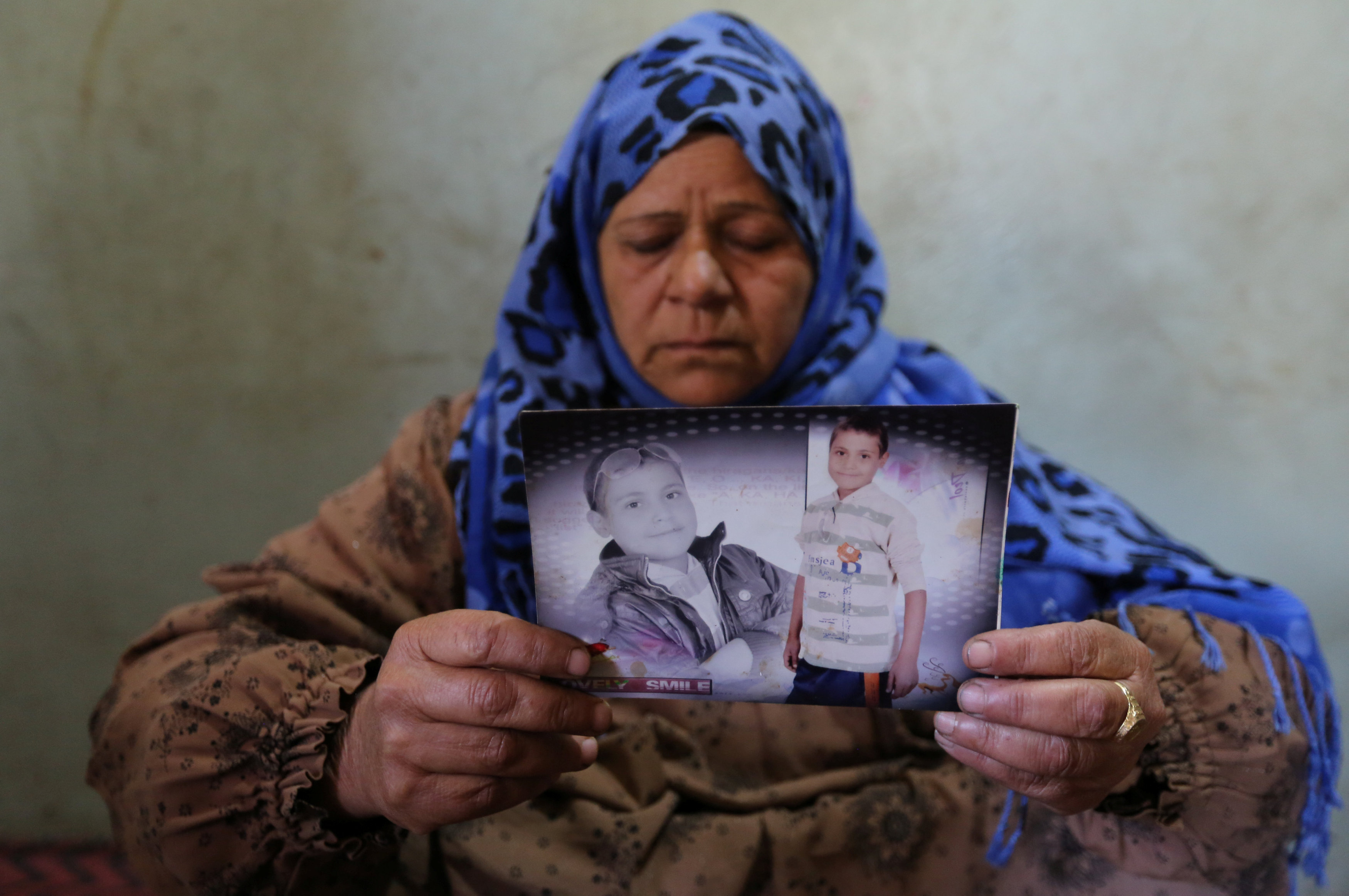 Ayat el-Sayed with a photograph of her teenage son El-Sayed Raaouf at the family home in the village of Kafr Dewaeda, in the province of Al-Sharkia, Egypt/Mohamed Abd El Ghany, Reuters
Ayat el-Sayed with a photograph of her teenage son El-Sayed Raaouf at the family home in the village of Kafr Dewaeda, in the province of Al-Sharkia, Egypt/Mohamed Abd El Ghany, Reuters
Reuters has identified the owners of the doomed ship and the ringleaders of the voyage, as well as the people-brokers who assembled the migrants in Cairo and Alexandria and took their money.
The investigation demonstrates the gaps in international law enforcement that make it easy for human smugglers to pursue their deadly trade in the Mediterranean. But it also shows what could be done if authorities chose to make a priority of investigating migrant deaths.
The official indifference to the disaster contrasts with how nations mobilized after EgyptAir Flight MS804 crashed in the Mediterranean on May 19, killing 66 people. Within hours of the crash, Egypt dispatched warships and air force planes to search for wreckage and survivors. France, Britain and the United States sent their own ships and aircraft. An investigation into what caused the crash and who was responsible continues in both Egypt and France.
Rob Wainwright, director of the European police agency, Europol, said that in hindsight his agency should have investigated the April sinking. Reuters inquiries might have exposed a “gap here in the collective response by Europe” to such cases, he said in an interview.
He said the news agency’s inquiries had “triggered our minds about how we can improve.” In late November he said that Europol would study evidence collected by Reuters with Newsnight – and would consider opening an inquiry into the case, together with Greece or another member state. “If we can find a way of expediting it and making it operational then we will try to do that.”
In Egypt, Judge Khaled al-Nashar, assistant to Egypt’s Minister of Justice for Parliamentary and Media Affairs, said he could not confirm what inquiries had taken place into the April sinking but further action was not ruled out. “If the occurrence of such a crime is proven, Egypt certainly will not hesitate to conduct the necessary investigations to uncover it and arrest the perpetrators and bring them to justice.”
Egypt’s special ambassador for migration, Naela Jabr, said security agencies were “doing their utmost” to fight illegal migration, arresting 5,076 people who tried to migrate illegally in the first six months of the year. Jabr said a people-smuggling law passed by parliament in October and ratified in November would help in the crackdown.
Some Egyptian lawyers said the government already had the power to impose justice in the case. They said that smugglers responsible for the voyage could be prosecuted for first-degree homicide, abetting illegal migration, and maritime safety breaches.
“I consider putting 500 people on this boat to be murder. There is no other way to describe it,” said Sabry Tolba, an Egyptian lawyer hired by the families of some of those who died.
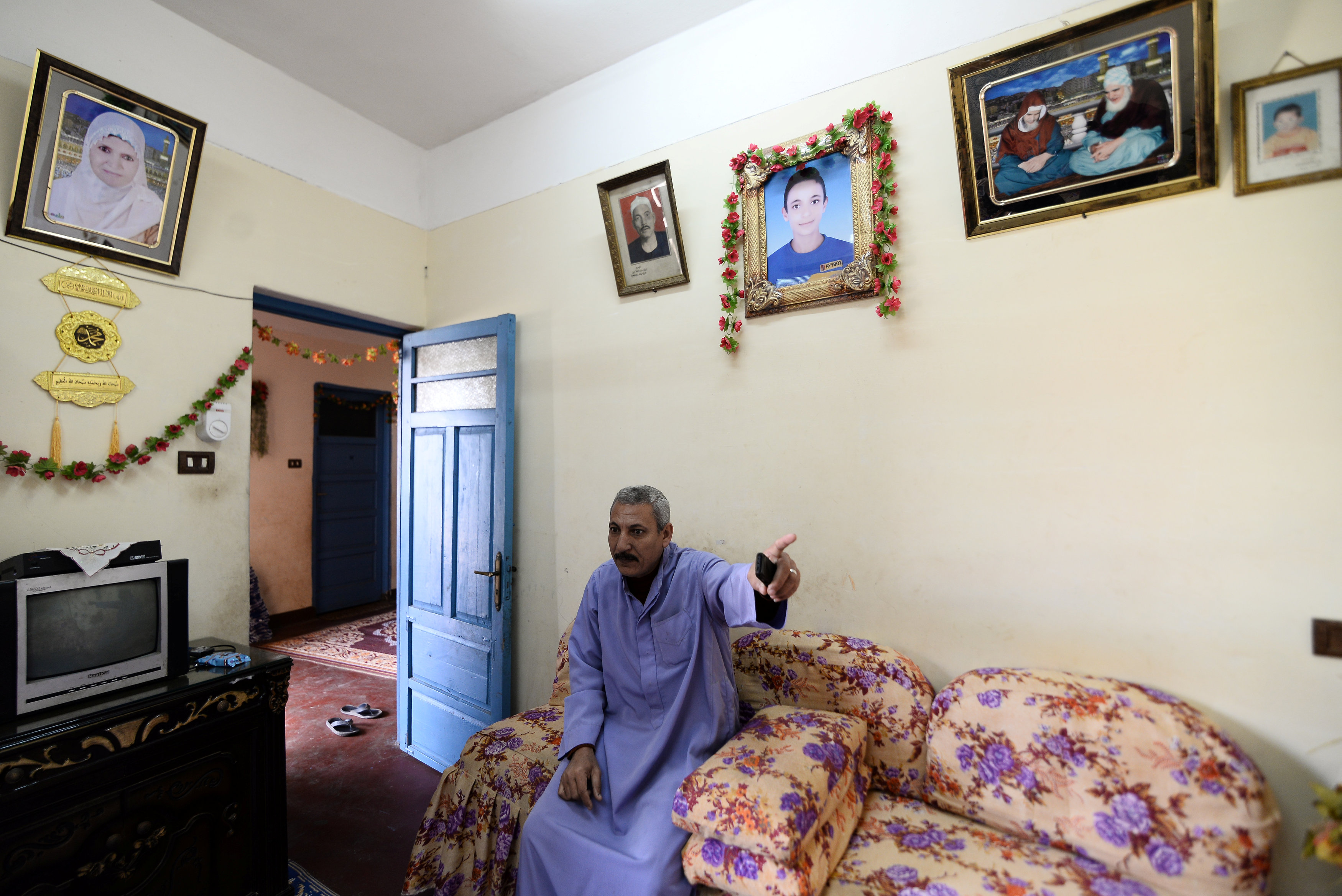 Saad Abass, father of teenage son Abass Reda, at the family home in the village of Meit Massoud in Aga, Egypt/Reuters stringer
Saad Abass, father of teenage son Abass Reda, at the family home in the village of Meit Massoud in Aga, Egypt/Reuters stringer
The November 2000 Palermo Convention against organized crime, signed by all of the nations involved in the tragedy, also requires countries to pass laws, take effective measures and “cooperate to the fullest extent possible” to prevent and suppress the smuggling of migrants by sea.
This account is based on interviews with people involved in all aspects of the voyage: survivors, relatives of the victims, smugglers, fishermen, coastal residents in Egypt, security and maritime officials, agents who acted as the middlemen between passengers and traffickers, and money changers who handled the cash. Reuters also analyzed social media networks to track the links between smugglers and their human cargo.
Among the obstacles that had to be overcome: Survivors, fearing repatriation to Egypt and retaliation from the smuggler gangs, initially lied about key details of the trip. Those lies, widely repeated by the media and by UN agencies, have helped delay bringing the perpetrators to account.
THE PEOPLE MARKET
In the spring of this year, crowds began gathering every day on Mekka el Mokrama Street in Cairo, where the Egypt headquarters of the United Nations High Commissioner for Refugees (UNHCR) is located. They were migrants, most of them from Somalia and Ethiopia, queuing to register with UNHCR so they could temporarily but legally live in Egypt.
On the street, brokers circled.
“Italy, Italy, Italy,” they shouted, as they hawked places on boats headed across the Mediterranean.
Over the winter, few boats had made that trip. But now the weather was clearing and the people-smuggling business was picking up. By August, more than 11,379 migrants would make it to Italy from Egypt, more than in all of 2015. The Mediterranean would prove deadlier than ever. According to the UNHCR, more than 4,663 people have died trying to cross the sea to Europe this year, a record.
One broker touting passage was Hamza Abdirashid, a slim and well-dressed man whose Facebook profile says he comes from the city of Hargeisa in the breakaway part of Somalia known as Somaliland.
Sandhool, the young Somali from Mogadishu, met him in the Cairo suburb of Nasr City, where Somali migrants often congregate. “He came around in a car and asked me if I wanted to go to Europe,” Sandhool said.
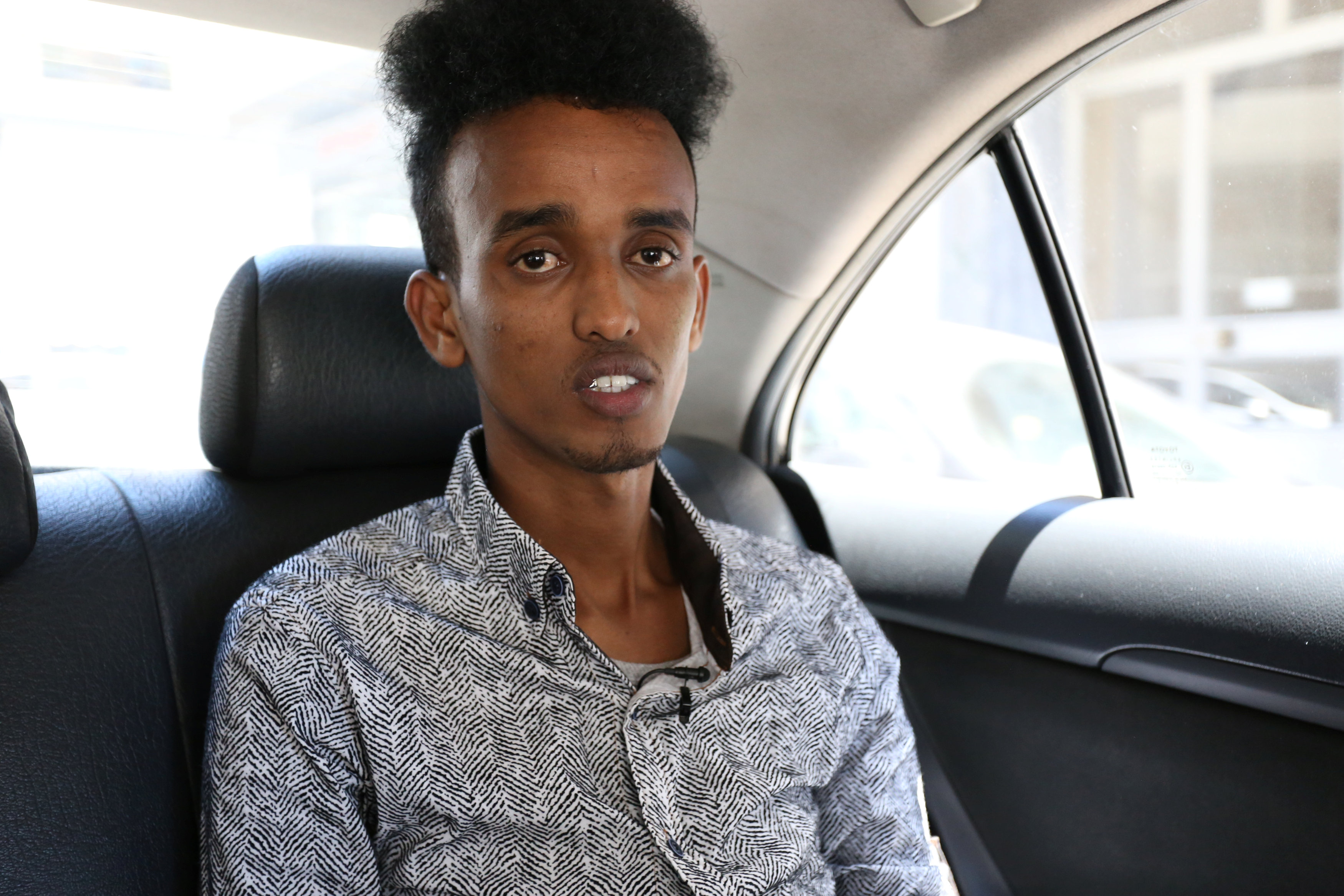 Sandhool in the back of a taxi in Athens/Stephen Grey, Reuters
Sandhool in the back of a taxi in Athens/Stephen Grey, Reuters
The price was $1,800, Sandhool said. But “Hamza was saying if you take five people along, you will get two for free.” Sandhool said he later negotiated a $500 discount for himself with one of Abdirashid’s deputies, another Somali in Cairo.
Brokers charged passengers a fee of between $1,300 and $2,500, based on the traveler’s ability to pay, according to more than a dozen survivors interviewed. People involved in the business said the broker typically kept $200 of that, passing on the rest to the smugglers.
Several other migrants identified Abdirashid as the main broker for Somalis on the April voyage. Other brokers handled other nationalities. The middlemen usually come from the same ethnic group as the migrants.
The brokers used messaging on apps like Facebook, WhatsApp and Viber to negotiate with migrants. Records of those interactions could help law enforcement identify the brokers. An analysis of the Facebook friends of Abdirashid, the broker, shows he was connected to at least 10 of those Somalis on board the ship: six victims and four survivors.
Contacted on social media, Abdirashid declined to comment about his role as a broker, saying that the issue of illegal migration was sensitive.
“I’m a student, I don’t want to face problems,” he wrote in a WhatsApp conversation with a reporter.
GOING DOWN
In the evening of Thursday, April 7, a fleet of minibuses moved through the suburbs of Cairo, picking up Somalis and Ethiopians from lay-bys and street corners.
The buses were tourist vehicles, hired from a Giza-based company called Honest Tours, said one broker. Emad Monir, transport director of the company, said he was unaware of this trip or any other involving illegal migrants. “It is like stopping a taxi on the street, the driver doesn’t ask the client why is he going to the place.”
The buses carried the migrants for three hours to the port city of Alexandria.
Sandhool and his fellow travelers were handed to another group of Egyptian smugglers who would earn around $220 a head. For that, the smugglers put migrants temporarily in takhzeen, or storage – apartment buildings in Alexandria or isolated compounds close to the shore. They also took care of el Nazla, or going down, shifting the migrants into waiting boats.
It was at this stage that the first known deaths occurred.
At dawn on Friday, April 8, after a night waiting in isolated car parks with curtains drawn, a group of Somalis and Ethiopians were offloaded from buses on Alexandria’s Miami Beach. The beach is a tourist destination and is typically thronged with pleasure-seekers.
It is also fenced off and usually protected by guards. But no guard was visible that day and nobody intervened when smugglers armed with pistols assembled the migrants into groups of 20 or 30 and loaded them onto hasakas, the small wooden boats with engines that ply this part of the coast.
“Everyone was being grabbed and thrown on. People were sitting on top of me and I felt a lot of pressure,” said Sandhool. “Then the boat started moving.”
Within sight of the beach, and well inside Egyptian territorial waters, the hasakas pulled up alongside a small wooden fishing boat with a cover shading its deck. So close to shore, the swell was treacherous. As people struggled out, Sandhool’s hasaka began to tip. AbdiAziz Shiyo, a 23-year-from Hargeisa who had played soccer with Sandhool in Cairo, spotted the danger.
“Keep the balance!” he shouted.
It was too late. The hasaka overturned and tossed everyone in the water. Shiyo drowned, as did Asad Elmi, a pregnant woman in her twenties, and an unrelated six-month-old child. Others, including Sandhool, managed to scramble onto the fishing boat.
Osman Asad Mohamed, a migrant from southern Somalia, also witnessed the deaths. He said smugglers had a spare wooden boat ready to take away the bodies and collect any abandoned luggage.
Abdelaziz Yusuf, a criminal lawyer in Cairo, said Egyptian maritime law required all vessels to carry communication equipment and to call for help in an emergency. If anyone died, Yusuf said, the sailors could be prosecuted either under maritime law, for failure to perform their duties, or under civilian law for deliberate failure to act to save a life when they were able. The latter could be deemed premeditated first-degree murder under Article 230 of the Egyptian penal code, which carries a death penalty.
By now, the wind was picking up and the swell building. Nevertheless, the fishing boat – about 15 meters (50 feet) long, painted white with a blue and gold stripe along its hull – set off with nearly 200 people aboard.
Local sailors identified the boat as one that operated from the small, military-controlled port of Abu Qir further along the coast from Miami Beach. Local fishermen and security officials said smuggling from that port was controlled by Ismail al-Bougy, a powerful 41-year-old who got his start hawking seafood on the street. Bougy’s real name, according to the security officials and a police report seen by Reuters, is Ismail Ali.
The wooden fishing boat – or “middle boat,” as it became known – was to ferry the migrants to a much larger ship. Survivors would later refer to the main vessel as the “big boat.”
That big boat was a deep-sea fishing trawler. It was painted blue and measured around 22 meters (72 feet). According to survivors, it had three decks: a top deck exposed to the weather, a main working deck, and a refrigerated fish-hold accessed via a narrow hatch and ladder.
By Friday night, the trawler was stationary offshore, rolling and pitching in growing waves. Instead of fish, the trawler’s hold was loaded with more than 300 passengers who had been brought out from other beaches over the previous two days. The smugglers planned to cram another 150 to 200 people into the load.
SHIPS AND SMUGGLERS
Egypt’s Mediterranean coast is tightly controlled by the nation’s Coast Guard and military. Large sea-going vessels can only depart from a handful of creeks or Nile branches – all watched by Coast Guard towers. For this reason, the identities of ships and crew that run smuggling missions become well-known among fishermen and local Coast Guard officers.
Egypt’s Coast Guard did not respond to a request to comment.
Local fishermen and other smugglers say the “big boat” that sank in April was built in a shipyard and registered at the port of Rashid, the modern name for ancient Rosetta, about 50 km (30 miles) northeast of Alexandria.
One of Egypt’s top people-smugglers, who spoke on condition of anonymity, identified the sunken trawler as the Abu Nawal, registered in Rashid as RSH-123. The smuggler, who is wanted in Italy for allegedly organizing other illegal voyages, supplied a set of photographs of the vessel and said he knew about this trip because he was asked to recruit passengers for it but declined.
He said fishing boats were made in Rashid specifically for trafficking. “Nowadays we make boats to work in this business, not to fish. It is a million times more profitable.” With fishing, the net was often empty. But on a smuggling trip, “you can make $400,000.”
The Abu Nawal departed Rashid on March 9 to go fishing and has not returned, according to an April 16 Coast Guard report received by the fisheries ministry and seen by Reuters.
The ship’s original owner, Hassan Yehia, is from Burg Mighizel, a village that lies a kilometer across the Nile from Rashid. The village is reputed to be the smuggling capital of the Nile Delta.
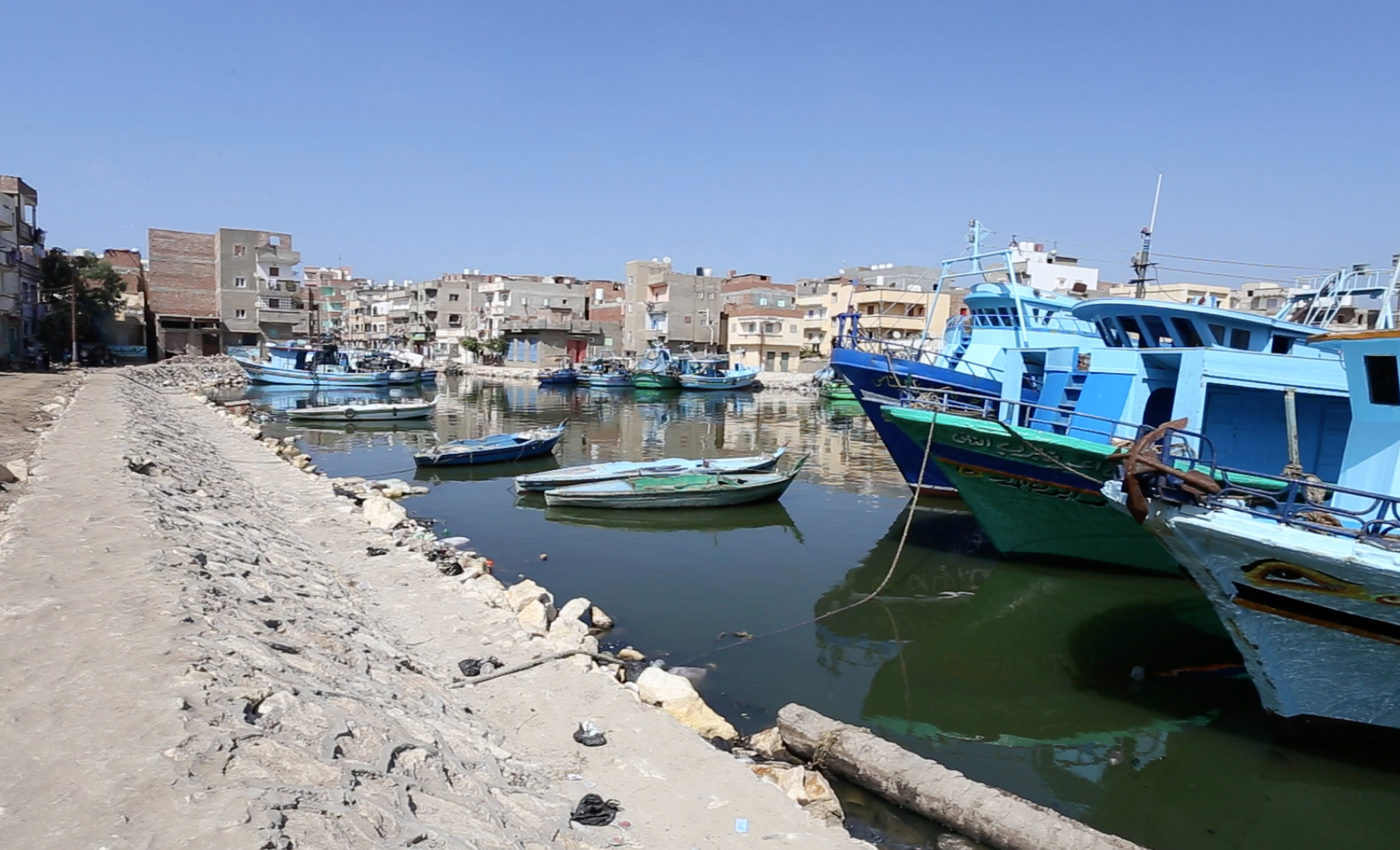 Burg Mighizel/Stephen Grey, Reuters
Burg Mighizel/Stephen Grey, Reuters
Yehia says the Abu Nawal was named after his daughter and mother. He gave conflicting accounts of his connection to the ship. He first said he sold the Abu Nawal in March to a Libyan merchant, but later he said he still half-owned the vessel, which was now in Libya.
But the people-smuggler said Yehia sold the ship in March to two men he identified as the ringleaders of the April voyage: Bougy, the smuggler from Alexandria, and his partner, Ahmed Obeid, 51. Obeid is known locally as Dr Obeid, or simply “The Doctor.”
Security officials and fishermen described Obeid as the leading smuggler in Burg Mighizel. Both Obeid and Bougy were detained in prison between 2005 and 2008 as a threat to security under Egypt’s three-decades-long state of emergency that was lifted in 2012, according to a senior Egyptian security official. The official said the pair remained pivotal in the smuggling business.
A broker directly involved in recruiting passengers for the April voyage independently identified Obeid and Bougy as organizers of the fated trip. So did two relatives of Egyptian victims on the voyage, who separately learned of their relatives’ fates by questioning the brokers.
Yehia, the ship’s original owner, said he knew Obeid, who was from the same village. “You probably already know how dangerous this man could be,” he said. “Dangerous to an extent that would make me and others not talk about him.”
Police say both Obeid and Bougy have been sentenced in absentia several times by Egyptian courts for offenses connected to illegal migration. The latest conviction in absentia, for a misdemeanor over the trafficking of several children who went missing in April, came after a complaint from parents. Both were sentenced to a year in jail, but remain at-large.
Lawyers said police and prosecutors have not examined any connection with the April sinking. Lawyers also said those convicted of fraud would likely appeal their sentence if they were ever apprehended.
Obeid did not respond to messages left at his home in Burg Mighezel. His son Ibrahim said he acknowledged his father had arranged migrant trips but said there was no evidence tying him to the deadly voyage.
“If he arranges a trip, he does it in a way that pleases God,” Ibrahim said, laughing. “You’ll never find any smuggler using his real name, so there isn’t real proof that it’s my father.”
Bougy could not be reached for comment.
THE DROWNING
It was about 2 a.m. on Saturday, April 9, when the middle boat reached the trawler. It was pitch dark and well beyond sight of the Egyptian coast. According to one fisherman with a close connection to smuggling gangs, the two vessels met a couple of hours’ sailing off the port of el-Saloum, near the Libyan border.
In a rough sea and high winds, the middle boat was roped to the trawler. The smaller vessel’s passengers, between 150 and 200 people, were forced to clamber across.
As the trawler, or “big boat,” rocked about, its growing load suddenly shifted to one side. It listed, and then began to keel over.
In panic, the crew on the middle boat cut the tethering lines and pushed their craft, which still had 27 migrants aboard, clear of the trawler.
Sandhool was now on the trawler’s top deck. He began to pray. “People on the boat all started screaming and crying together,” he said. Hundreds were still crammed in the hold.
Sandhool was thrown into the water. “Myself and a couple of young guys started to swim away to try and save ourselves.” Sandhool and a few others had brought along lifejackets; most had not.
Muaz Mahmud, an Ethiopian, was also thrown overboard with his wife and two-month-old infant. He survived. His family did not. “I was trying to save them,” he said later, tears sweeping down his cheeks. “But I couldn’t save them. They slipped away. Everybody was climbing over and hanging on me but I couldn’t even hold on myself. So I took off all my clothes, left everything in the sea and tried to swim. I swam towards the light.”
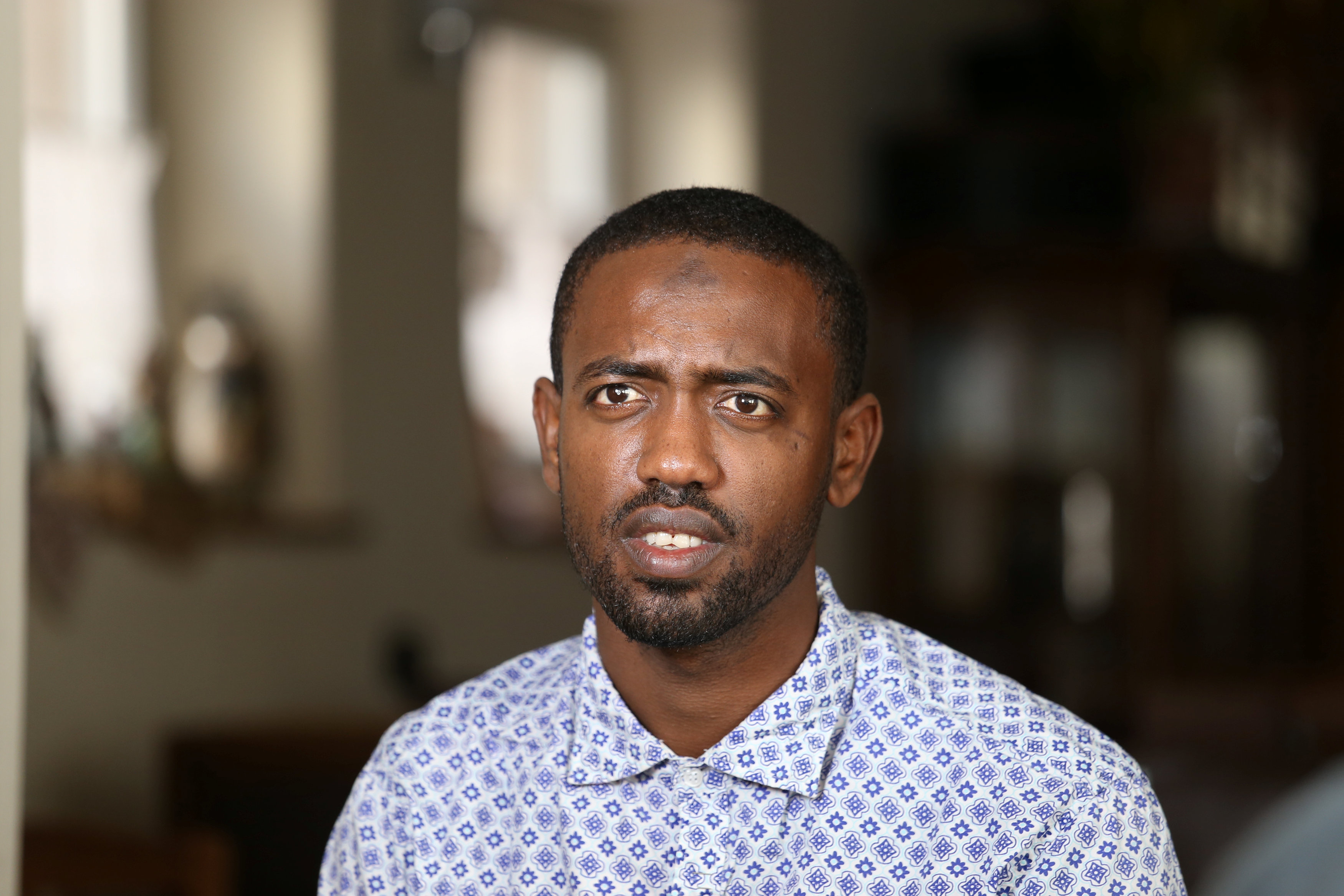 Muaz Mahmud/Stephen Grey, Reuters
Muaz Mahmud/Stephen Grey, Reuters
That light was the single torch on the middle boat. For the next half-hour, the vessel moved through the water searching for the trawler’s crew and its captain, whose name was Salem. The sailors on that boat ignored the pleas of the migrants in the water and brandished knives, threatening survivors like Muaz. Nevertheless, he made it aboard. But when he grabbed someone else’s hand to pull him from the sea, he said a crewman punched him until he let go. The same crewman cut loose a rope that survivors were using to clamber up.
Gamachis Abdullah, another Ethiopian student, watched helplessly from the middle boat as his mother and two brothers drowned. His eldest brother, Ramadan, nearly made it. “He was shouting up to me but the crew forcibly made us leave everyone and go,” Abdullah said.
The smugglers rescued Salem and two of the trawler’s crew, but within minutes Salem died of an apparent heart attack and his body was dumped overboard. Then the smugglers sailed away, leaving behind, according to Muaz, at least 100 people still alive in the water.
Yusuf, the Cairo lawyer, said the overloading of the trawler amounted to premeditated murder. Accepting such a massive load, he said, ensured the vessel had little chance of arriving safely. And just as with the drownings near the shore, he said, while there was no specific Egyptian law about sea disasters, the crew’s failure to rescue “when it was in their hands to save people” could be interpreted by courts as murder under Egypt’s penal code.
Nashar, the senior official in the justice ministry, said a murder charge would require proof of a “special intent to destroy a soul.” In smuggling cases, he said, “the purpose is to transport individuals and smuggle them in exchange for profit.” But smugglers could be charged with manslaughter, which carries a sentence of up to 10 years in jail. Laws against human trafficking, immigration and maritime laws, and laws protecting women and child rights could also have been violated.
The middle boat was equipped with radios, cell phones and a satellite phone, but none of its crew attempted to alert authorities, according to survivors. Instead, they said, the crew discussed whether to kill those left alive.
Osman Asad Mohamed, who understood Arabic from living in Yemen, said the proposal came from a tall, thin, pale-colored smuggler, the one who had cut the ropes between the two ships. “I remember his words clearly: ‘Let’s kill all of them and bring our boat back. Most of them are dead; they are of no value to us now.'”
Some survivors were so petrified by those words they hid in the middle boat’s hold, clutching makeshift weapons for defense. But the smugglers never carried out the threat, said Mohamed, because they decided they were outnumbered by migrants.
The crew’s failure to call for help was costly, say maritime safety professionals, because many of those in life jackets could have survived for hours. A senior Greek Coast Guard officer said the sea lanes off Egypt and Libya are busy with traffic exiting the Suez Canal. Those ships could have assisted had the survivors called, he said.
Mohamed recalled that just before the trawler sank, he noticed the lights of big ships in the distance.
RESCUE AND INACTION
At about 12.30 p.m. on April 16, a week after the disaster, the headquarters of the Italian Coast Guard in Rome received its first word of the sinking: a distress call from a satellite phone. The call came from one of the survivors aboard the middle boat.
By 2.19 p.m., the Italian coast guard had determined the boat was lying in international waters, within Greece’s “rescue coordination zone.” By treaty, maritime nations have divided the sea up into zones. Each country takes responsibility for rescue operations in its zone, even if it asserts no legal jurisdiction outside territorial waters, typically 12 nautical miles off the coast.
Just under two hours later, Greek Coast Guard officers in the port of Piraeus instructed a Dutch-operated bulk carrier, the 550-foot Eastern Confidence, to change course and find the boat full of survivors.
Obliged by maritime law to assist with the rescue, but not to collect evidence, the crew of the Confidence did not check the boat for identification marks or serial numbers that could have shown where the smugglers came from. The Confidence’s operators, Orient Shipping Rotterdam, told Reuters the basic details of the rescue but declined further comment.
The Confidence ferried the survivors to the Greek port of Kalamata. It was here that they began to tell their story to the Greek Coast Guard, to the media, to agencies such as UNHCR, and, via phone, to families and friends. The survivors said that up to 500 people had drowned.
But while Greek authorities helped in the rescue and aided the survivors, they decided not to investigate the sinking. A source with knowledge of the case said that Greece’s Coast Guard did not refer the case to a criminal prosecutor because there was no indication any crime had been committed on Greek territory.
Both the Coast Guard and Nikos Paraskevopoulos, the justice minister, declined to comment.
If Greek authorities had questioned survivors more closely, they might have learned that some of their accounts were untrue – notably, the initial claim that the migrants had left from Tobruk in western Libya.
Based on interviews with survivors in Greece, the UNHCR repeated this erroneous account in an April 20 press statement.
In fact, nobody had left from Tobruk.
All the migrants set sail from Egypt, according to brokers involved, relatives who spoke to victims just before they embarked, and Egyptian security officials.
Sandhool, the young Somali, originally said he had boarded in Tobruk. But he later revised his story. “I am really sorry I told you a lie,” he said, explaining that survivors had agreed on the false story because they were worried they might be deported from Europe to Somalia or Egypt.
Survivors also failed to disclose that four of the Egyptians on the middle boat were sailors employed in the smuggling gang. Mahmud, the Ethiopian survivor, said the four had urged survivors to lie. “The Egyptian smugglers were with us, and they told us that the Greece authority would return us . . . if we tell them that we are from Egypt. This is the only reason why we told we are from Tobruk.”
Other survivors said they were grateful to these crewmen for keeping them alive and taking them to Greece.
NO MANDATE
Like Greece, Frontex, the EU border agency, did not investigate. Izabella Cooper, a spokesperson, said it had no mandate because launching investigations into potential crimes was a “power reserved for national authorities.”
The European Union runs a naval mission off the Libyan coast – Operation Sophia – to identify and capture smugglers’ vessels. In practice, it also operates as a rescue service, picking up more than 16,000 migrants from the sea from January through August 2016.
Captain Antonello de Renzis Sonnino, the operation’s chief spokesperson, said the force operated in an area “just outside the Libyan territorial waters” and has so far successfully identified 89 smugglers and traffickers that Italian authorities could prosecute. But asked about the April sinking, he said that based on “the information we have, the disaster occurred far away from where we had our military vessels.”
NATO, which runs a separate naval mission in the Aegean to monitor illegal migration, began operations against people-smuggling in the Mediterranean last month. A spokeswoman said: “No ships under NATO command were mandated to engage directly in counter-human trafficking activities in the Mediterranean in April.”
UNHCR, which assisted the survivors when they reached Athens, said it was not its job to investigate. “UNHCR is there to help the survivors and warn travelers tempted to take the journey. We do not have the investigative mandate to go after organized crime,” said chief spokesperson Melissa Fleming.
 Ezzat Ali (L) with a photograph of his teenage son Fares Ezzat, with his sister-in-law Halawethorn Abdel-Wahad at the family home in the village of Meit Massoud in Aga, Egypt/Reuters stringer
Ezzat Ali (L) with a photograph of his teenage son Fares Ezzat, with his sister-in-law Halawethorn Abdel-Wahad at the family home in the village of Meit Massoud in Aga, Egypt/Reuters stringer
One entity does acknowledge it could investigate: Europol. Wainwright, the Europol chief, said his agency exists to help support such investigations, although it was required to get the cooperation of a member state.
Wainwright said he was willing to take the case on and would raise it at senior levels in Greece. But, he said, the country was short of resources and already burdened by a huge influx of migrants. Any response, he said, should “be a European Union response.”
Law enforcement in Europe was increasingly overwhelmed by the scale of challenges posed by illegal migration, he said, whether it was drownings or child migrants who go missing. In contrast, if a single local child went missing in England, France or Germany, it attracted huge resources for police. “It’s almost a parallel world we are living in,” he said. “It’s very frustrating.”
Somalia’s Foreign Minister Abdusalam Omer said that the government asked Somali embassies to talk to officials and private organizations, such as those working with migrants, in Italy, Greece, and Egypt.
He declined to detail what help Somalia received, but urged a more compassionate response. “If you can deploy a flotilla of ships . . . to stop piracy off the coast of Somalia, why can one not deploy a flotilla of ships that saves lives in the Mediterranean? These are our children. And when I say our children, it is not just the Somali children, it is all our children, it is humanity.”
THE TRAIL TO CAIRO
Egypt also chose not to investigate. Local police in Alexandria mounted a partial inquiry into the disappearance of nine Egyptian teenage boys who left for Italy in April, but have not linked the boys’ disappearance to the sinking.
One father, Abdo Abdul Hamid of Alexandria, gave a statement to police. That led to a prosecutor’s report, reviewed by Reuters, which named some of the smuggling ringleaders. Six of them, including Bougy and Obeid, were convicted in absentia by a court in Alexandria of defrauding the boys’ families. All remain at-large.
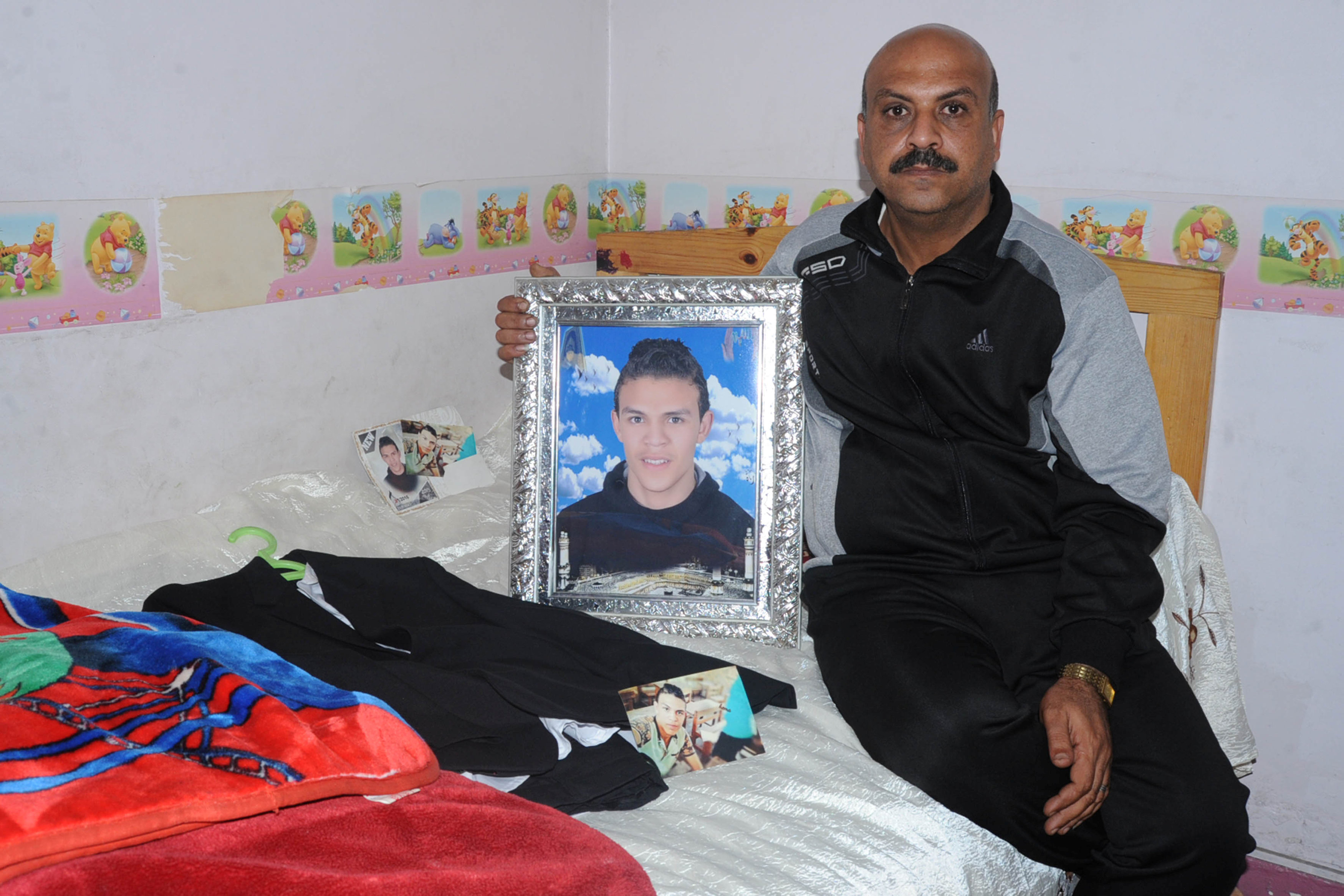 Abdo Abdul Hamid with a photograph of his teenage son Ibrahim in the boy’s bedroom at the family home in Alexandria, Egypt/Reuters stringer
Abdo Abdul Hamid with a photograph of his teenage son Ibrahim in the boy’s bedroom at the family home in Alexandria, Egypt/Reuters stringer
“These people have to get punished,” Abdul Hamid said. “I will stay after them until they all go to prison.”
No Egyptian body has looked into the shipwreck itself, two senior security officials confirmed. Law enforcement officials said an ineffective legal system discourages action, and also blamed the pressure of other work. One senior security source said that illegal immigration was nothing new, and “the priority is security and drugs at the moment.”
Under international law, if any of the ships involved in the disaster were flagged or registered in Egypt, as large fishing trawlers like the Abu Nawal are, then Cairo had a clear mandate and possibly even an obligation to investigate the disaster, according to Niels Frenzen, director of the Law Immigration Clinic at the University of Southern California.
Nashar, the senior official in Egypt’s justice ministry, said that investigations into illegal migration were difficult because they often required collecting evidence and chasing criminals across borders, and because migrants were often reluctant to give evidence.
But, he said, “I can confirm it is not in the interests of the investigating agencies, whether the general prosecutor or any relevant law enforcement authority, to cover up on such crimes.”
Nashar said that after another sinking in September, Egypt had rushed through the new law “to combat the crime of illegal migration.”
In May, the six Egyptians who’d been rescued and taken to Greece – two teenage migrants and four crew – agreed to be sent home to Egypt. According to Cairo airport police records, the six told authorities they had left from an Egyptian beach.
That gave Egypt another reason to investigate. Instead of probing further, though, the police charged the six with crossing a frontier illegally.
The two teenage survivors and four smugglers were fined and paid 100 Egyptian pounds apiece, or $11. So far, this is the only punishment meted out in the sinking of the Abu Nawal.
Stephen Grey reported from Athens, Cairo and Alexandria; Amina Ismail from Cairo, Alexandria and Kafr-el-Sheikh; Additional reporting by Sameh Ellaboody in Cairo, Alexandria, Kafr-el-Sheikh and Damietta; Karolina Tagaris in Athens; Crispian Balmer and Steve Scherer in Rome; Edmund Blair in Nairobi; Abdi Sheikh in Mogadishu; and Hussein Ali Noor in Hargeisa.
–
See also: In Cairo, Ethiopia’s Oromos Lose Hope With UN Refugee Agency.
–
Comments welcome.
Posted on December 18, 2016


